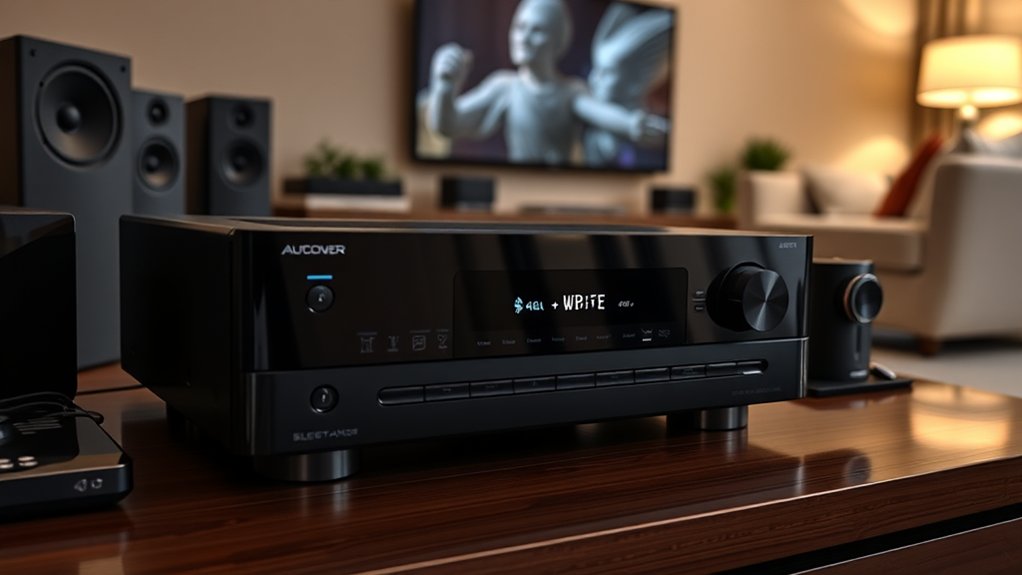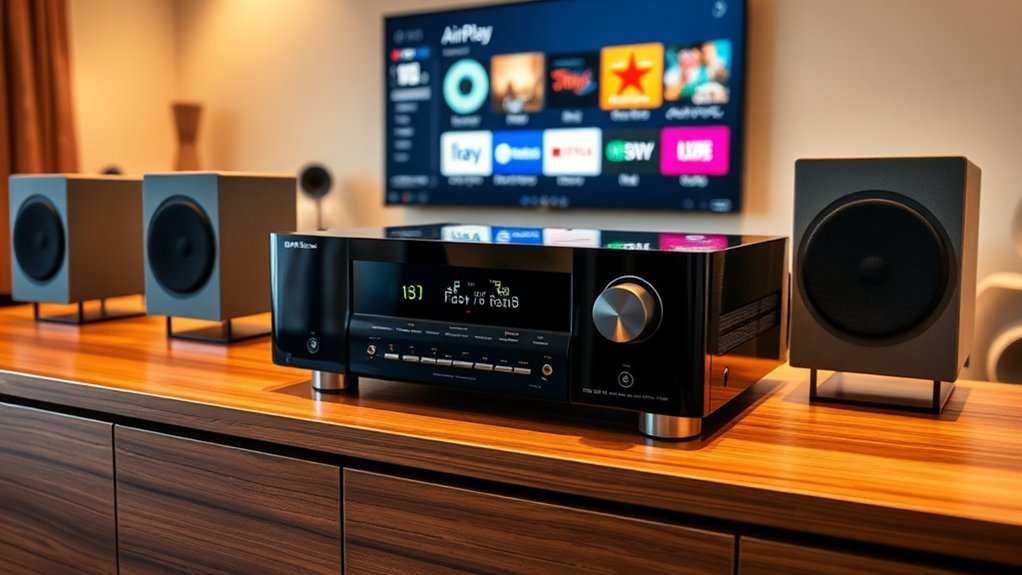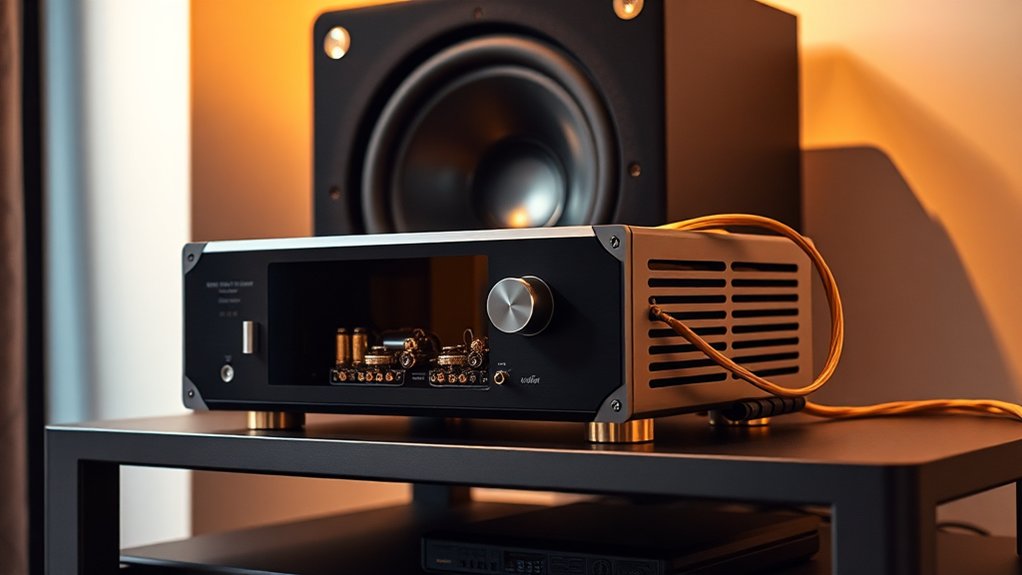To match your AV receiver power to your speakers, start by checking the RMS power ratings of both; ideally, the receiver’s wattage should match or slightly exceed this number. Don’t forget about impedance, measured in ohms—mismatched values can cause inefficiencies or damage. Additionally, take note of speaker sensitivity—the higher it is, the less power you’ll need for the same sound level. Think of it like finding the perfect coffee-to-water ratio; get it right, and you’ll savor every note. Stick around, and you’ll find more tips!
Key Highlights
- Ensure the amplifier’s wattage matches or slightly exceeds the speakers’ RMS power rating for optimal performance.
- Check the impedance of both the receiver and speakers to ensure compatibility and prevent inefficiency.
- Choose higher sensitivity speakers to require less power while delivering more sound output.
- For dynamic audio, aim for an amplifier wattage about 1.5 to 2 times the RMS rating of the speakers.
- Distribute power effectively across multiple channels in home theater receivers to avoid distortion and provide balanced sound.
Understanding Speaker Power Ratings

When diving into the world of audio equipment, you might hear various terms tossed around, leaving you feeling like you’ve stepped into a foreign language.
Understanding speaker power ratings is essential for making sense of it all. The most reliable figure you can rely on is the RMS (Root Mean Square) power, which means the continuous power your speaker can handle without damage. Conversely, Peak Power shows the maximum your speakers can tolerate for short bursts—imagine a quick sprint rather than a marathon. Avoid Damage is crucial; overloading your speakers can lead to permanent damage, while underpowering may result in distortion that diminishes sound quality.
Then you’ve got Max and Program Power, which can sometimes feel like exaggerations. So, stick to RMS when matching your speakers and amp, ensuring your gear sings in harmony rather than causing heart-wrenching distortion.
Importance of Impedance Matching
Matching impedance in your audio setup is like ensuring your speakers and amplifier are on the same wavelength, leading to a smoother and more enjoyable listening experience. Impedance, measured in ohms, reflects how much opposition the speakers and amplifier provide to electrical current. When properly matched, the amplifier transfers maximum power without distortion, which means clearer sound and a fuller experience. Imagine trying to fit a square peg in a round hole; that’s what mismatched impedance feels like—inefficient and potentially damaging. Proper matched impedance allows for optimal power transfer between amplifier and speakers. Additionally, speaker impedance ratings often come in standard values such as 4 ohms or 8 ohms, so it’s essential to match these ratings with your amplifier for the best performance.
You risk overheating your speakers or stressing your amplifier, which is never a good idea. Always check specifications before pairing; after all, nobody wants a meltdown in an audio setup—unless you’re talking about your favorite tunes heating up!
Evaluating Speaker Sensitivity
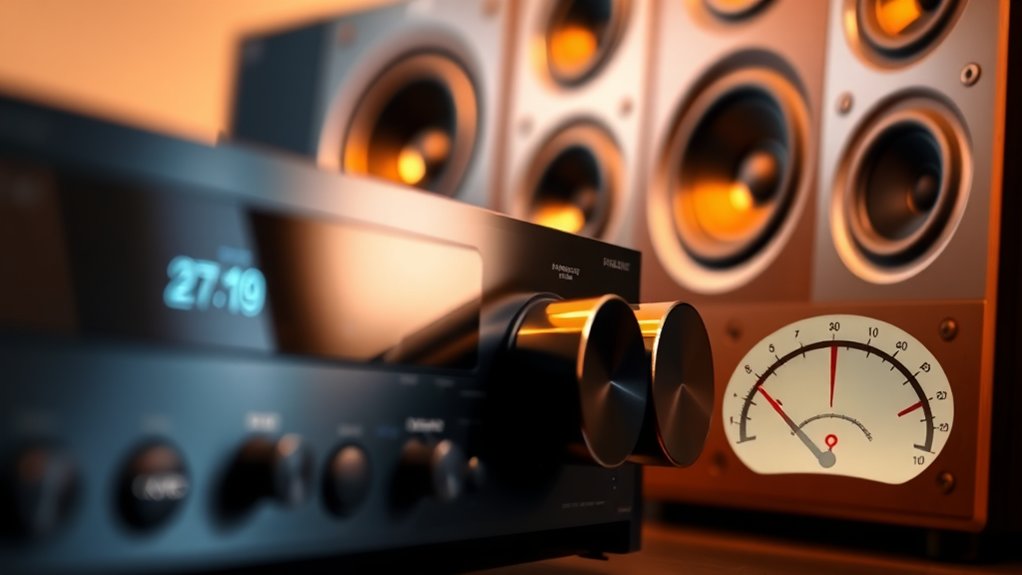
Understanding speaker sensitivity is vital for anyone looking to achieve an ideal audio experience, especially if you want to avoid frustration when cranking up the volume.
Basically, speaker sensitivity measures how effectively a speaker converts power into sound, quantified in decibels (dB) at a distance of 1 meter with 1 watt of input. If a speaker has a sensitivity of 87 dB, it’ll sound three decibels louder than one rated at 84 dB with the same power.
Speaker sensitivity indicates how well a speaker transforms power into sound, measured in decibels at a specific distance and power level.
This means that higher sensitivity speakers typically require less power from your amplifier, leading to an efficient system. Higher sensitivity ratings enhance overall listening experience, indicating how efficiently a speaker converts power into sound, affecting loudness. Additionally, consider the use of immersive audio technologies that can further enhance your sound experience depending on your setup.
Nevertheless, keep in mind that your room’s acoustics can affect readings, so take the environment into account when evaluating sensitivity—after all, nobody wants their sound to be muffled by echo, right?
Safe Wattage Guidelines
Finding the right wattage for your amplifier isn’t just a minor detail; it’s crucial for achieving ideal sound quality and protecting your speakers.
Ideally, your amplifier should match the RMS power rating of your speakers, or even slightly exceed it, to enjoy clean power without distortion or clipping. Think of RMS as the everyday power your speakers can handle, whereas the max power is like a sudden sprint: fine for short bursts, but you don’t want to do it constantly.
Underpowering can lead to distortion, whereas overpowering can roast your components alive. So, aim for an amp that offers about 1.5 to 2 times the RMS rating—it’s like having extra bandwidth to tackle dynamic sound without drama.
Tips for Choosing the Right AV Receiver
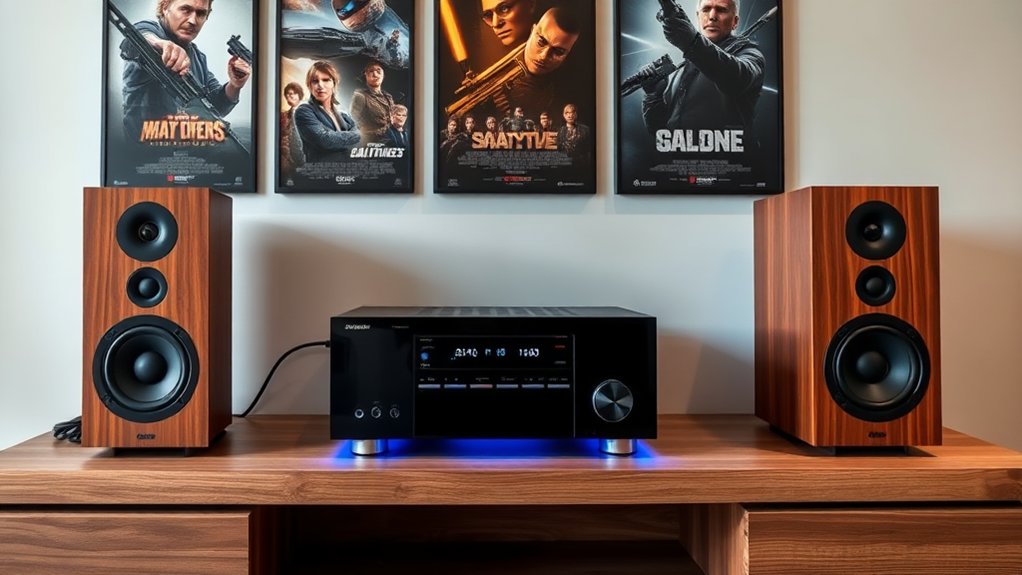
Once you’ve grasped the basics of safe wattage guidelines, it’s time to contemplate the broader picture when selecting an AV receiver that fits your audio needs.
First, match the receiver’s power output to your speakers’ specifications—aim for the higher end of their recommended wattage for clearer sound and extra headroom during those exhilarating movie scenes.
Ensure your receiver’s power output aligns with your speakers’ specs for optimal sound clarity and performance during exciting viewing moments.
Don’t forget about impedance, either; pairing a 4-ohm speaker with an 8-ohm receiver could cause issues.
Additionally, consider speaker sensitivity; higher sensitivity means you’ll need less power for volume.
Oh, and keep in mind that home theater receivers often distribute power across multiple channels, so enough wattage per channel is key.
In short, pay attention to these factors for a better audio experience! Also, remember that sound quality is the top consideration when selecting speakers to enhance your overall audio experience.
Frequently Asked Questions
What Happens if Power Ratings Are Mismatched?
Mismatched power ratings can lead to distorted sound, overheating, and possible damage to your speakers or amplifier. Insufficient power results in weak audio, whereas overpowered speakers risk distortion and physical harm to their components.
Can I Use Subwoofer Power Ratings for Matching?
You can’t use subwoofer power ratings for matching directly. Subwoofers and speakers have different needs, so focus on RMS ratings and impedance compatibility instead, ensuring each component operates efficiently without strain or distortion.
How Do Room Acoustics Affect Power Needs?
Room acoustics greatly affect your power needs. If your room absorbs sound poorly, you’ll need more amplifier power to achieve the desired volume and clarity, especially in larger or untreated spaces. Consider acoustic treatments to mitigate this.
Does Speaker Size Influence Power Matching Requirements?
Yes, speaker size does influence power matching requirements. Larger speakers often need more power because of their bigger drivers, but sensitivity and impedance play vital roles. You should always consider these factors when selecting an appropriate receiver.
Are There Risks With Vintage Speakers and Modern Receivers?
Yes, there’re significant risks. Mismatched impedance can cause distortion, overheating, or even damage to your vintage speakers when paired with modern receivers. Always guarantee proper compatibility to protect your audio equipment and maintain sound quality.


